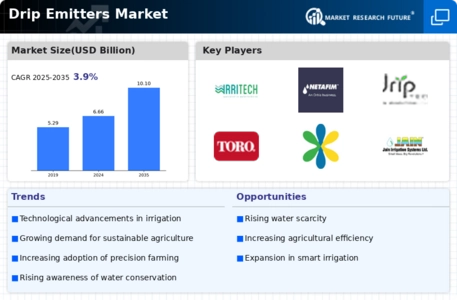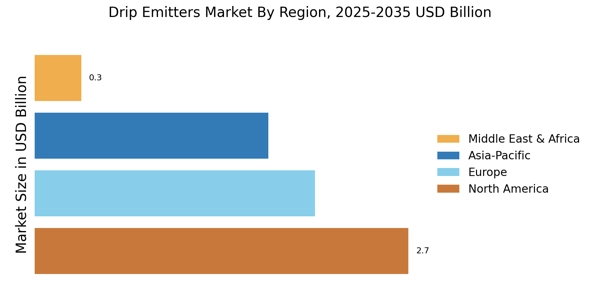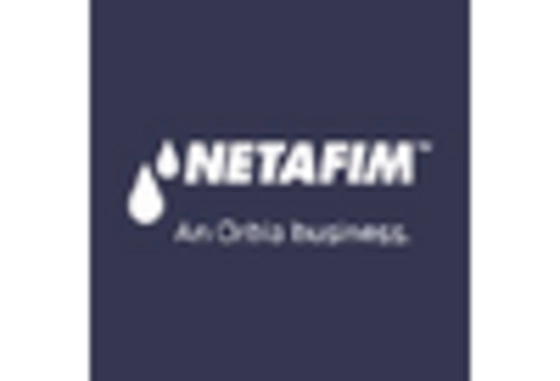Expansion of Agricultural Land
The expansion of agricultural land, particularly in developing regions, is contributing to the growth of the Drip Emitters Market. As more land is converted for agricultural use, the demand for efficient irrigation solutions becomes paramount. Drip irrigation systems are favored for their ability to deliver water directly to crops, which is essential in areas where water resources are limited. Recent estimates suggest that the area under drip irrigation is expected to increase by approximately 15% over the next five years. This expansion indicates a robust opportunity for the Drip Emitters Market to cater to the needs of a growing agricultural sector.
Increasing Agricultural Efficiency
The Drip Emitters Market is experiencing a surge in demand due to the increasing need for agricultural efficiency. Farmers are increasingly adopting drip irrigation systems to optimize water usage and enhance crop yields. This method allows for precise water delivery directly to the plant roots, minimizing evaporation and runoff. According to recent data, the adoption of drip irrigation can lead to water savings of up to 50% compared to traditional irrigation methods. As water scarcity becomes a pressing issue in many regions, the Drip Emitters Market is likely to see continued growth as farmers seek sustainable solutions to improve productivity.
Government Initiatives and Subsidies
Government initiatives aimed at promoting efficient irrigation practices are significantly influencing the Drip Emitters Market. Various countries have implemented subsidies and financial incentives to encourage farmers to adopt modern irrigation technologies, including drip emitters. These initiatives not only aim to conserve water resources but also to enhance food security. For instance, programs that provide financial assistance for the installation of drip irrigation systems have been reported to increase adoption rates by over 30% in certain regions. Such supportive policies are expected to drive the growth of the Drip Emitters Market in the coming years.
Rising Awareness of Water Conservation
The growing awareness of water conservation among consumers and agricultural stakeholders is a key driver for the Drip Emitters Market. As climate change and water scarcity issues become more pronounced, there is a heightened focus on sustainable agricultural practices. Drip irrigation systems, which are designed to minimize water waste, are increasingly recognized as a viable solution. Market data indicates that regions with severe water shortages are witnessing a rapid increase in drip emitter installations, with some areas reporting growth rates of over 20% annually. This trend suggests that the Drip Emitters Market will continue to expand as awareness of water conservation grows.
Technological Innovations in Irrigation
Technological innovations are reshaping the Drip Emitters Market, leading to more efficient and user-friendly irrigation solutions. Advances in sensor technology, automation, and data analytics are enabling farmers to monitor and manage their irrigation systems more effectively. For example, smart drip irrigation systems that utilize soil moisture sensors can optimize water application based on real-time data, resulting in improved crop health and reduced water usage. The integration of these technologies is expected to enhance the appeal of drip emitters, potentially increasing market penetration and driving growth in the Drip Emitters Market.


















Leave a Comment